Posted by Elena del Valle on July 23, 2008

Photos: Public Domain Pictures/Anna Cervova, Braille Institute, RL Public Relations
According to a Greenfield Online/Mintel April 2008 report, ethnicity affects the type of glasses survey respondents wear. Of those surveyed half of whites, blacks and Hispanics use bifocals while most Asians use regular glasses. These findings can be explained in part by the higher average age of whites and blacks.
It is also related to differences in household income: According to the U.S. Census Bureau, the average household income for Asians is $64,000 but only $48,000 for the average United States citizen. The higher income makes other vision correction options available and more likely for Asians like contacts and vision correction surgery.
The Mintel study also indicates more black and Hispanic consumers use colored or tinted contacts compared to other ethnic groups. These individuals are more likely to take advantage of colored contacts as a fashion accessory offering them hazel, blue or green eye colors. At the same time, Asian and Hispanics respondents expressed greater interest in corrective surgery.
“Segmentation by Level of Acculturation” audio recording

Presenter Miguel Gomez Winebrenner
Discusses
- Assimilation versus acculturation
- Factors that affect Latino acculturation
- How to know if someone is acculturated
- Number of years necessary for acculturation
- Effects of immigration debate on acculturation
- Three main ways of segmenting Latinos
Click here for details about “Segmentation by Level of Acculturation”
As Latinos age the rate of vision loss among adults over 40 increases. Many vision loss diseases prevalent among Hispanics, like glaucoma and diabetic retinopathy, can lead to blindness if left untreated. At the same time 41 percent of Hispanics in Los Angeles have very little knowledge about vision health or vision-loss diseases, according to a Survey of Public Knowledge, Attitudes, and Practices (KAP) Related to Eye Health and Disease conducted by the National Eye Institute in 2002.
Looking at the number of individuals in the communities it serves, the Braille Institute, a California non profit organization, realized it was necessary to focus closely on under served groups who need assistance and may not be aware it’s available. The organization has plans to reach out to Spanish speaking elderly Latinos in the Los Angeles metro area to draw their attention to issues of eye health care and vision loss prevention. To accomplish this goal the organization hired an independent agency, RL Public Relations (RLPR).

How someone with an eye illness might see an eye chart
“El Poder Sin Ver is a program Braille Institute created to specifically target the need for low vision services in the Latino community. We are planning a monumental community outreach effort to spread the word about our free services, all of which help people learn how to live a fulfilling life, even if their vision isn’t as good as it used to be,” said Courtney Goines, media relations manager, Braille Institute of America, Inc.
Difficulties with communication, lack of insurance, low income and cultural differences in health behaviors make the Hispanic population especially vulnerable to poor access to vision care. With the help of RLPR the institute hopes to increase awareness about the high incidence of vision loss among Hispanics in the Southern California community, and educating Hispanic elders about ways they can prevent and treat eye disease.

Roxana Lissa, CEO and founder, RL Public Relations
“We believe in spearheading public relations campaigns for socially-responsible organizations, especially if the good intention is geared towards the Hispanic community,” said Roxana Lissa, chief executive officer and founder of RLPR
The Braille Institute campaign will target Spanish-dominant Latino seniors (the group most affected by vision loss) in Los Angeles as well as those who influence their decisions, adult children, relatives and health care providers. The account will be led by Yanka Burgos, vice president out of the company’s Los Angeles office.
The agency plans to conduct a media outreach initiative focusing on outlets that reach Hispanic seniors in Los Angeles and those who influence them. As part of the campaign’s grassroots efforts agency representatives plan to reach out to community based organizations to promote Braille Institute services and provide information about eye health care in Spanish.
Braille Institute services are free and many of their counselors are already bilingual; some classes are provided in English and Spanish. The mission of the Braille Institute is to eliminate blindness and severe sight loss as a barrier to a fulfilling life.
Founded in the United Kingdom 35 years ago, Mintel is a supplier of consumer, media and market research. The company, with offices in Chicago, London, Belfast, Sydney and Shanghai, has been studying the United States Hispanic market since 2003.
Hispanic Marketing and Public Relations Understanding and Targeting America’s Largest Minority book
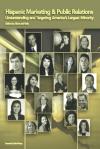
“A must resource for practitioners/professionals expecting to reach US Hispanics; also valuable for college programs in marketing, public relations and communications. Highly recommended.”
Choice magazine
Click here for information on the Hispanic Marketing & Public Relations books
Posted by Elena del Valle on July 22, 2008
Information provided by our Event Partner

September 9, 2008
Moscone West
San Francisco, CA
Exploring New Technologies, New Products and New Business Models!
Mobile Entertainment Live!, powered by Billboard, The Hollywood Reporter, Nielsen Mobile and AdweekMedia, will offer a new event format this fall that is designed to deconstruct the typical conference experience and give a greater voice to all attendees.
New technologies, new products and new business models will be the topics of the day, so Mobile Entertainment Live! regulars and newcomers alike are sure to find something innovative and exciting at this event!
This one-day conference will feature main-stage keynote interviews with industry experts as well as a full afternoon program dedicated to in-depth tracks on each of the major content areas. Each track will include a series of product demonstrations, presentations, interviews, feedback sessions and structured networking opportunities. The program will be staggered in such a way that attendees can take advantage of multiple tracks.
Music
Deep-dive sessions on the future of music content on mobile phones including ringtones, ringback tones, full-song downloads, sideloading, bundling, artist participation, promotional opportunities and mobile ticketing.
Video
Focused sessions on all mobile video-related content including on-demand video, streaming TV, original content vs. repurposed content, film, TV, animation and news.
Advertising
An examination of the various ways that mobile entertainment is drawing advertisers to mobile content through consumer acceptance, subsidized content, marketing programs as content services and more.
Community
A look into the highly anticipated world of mobile social networking and user-generated content including strategies/technologies for mobilizing social networks, content recommendation/sharing/gifting, mobile-only social networks, monetizing user-generated content, participation TV/events and blogging.
Contact Brittany.davies@nielsen.com for a Special Hispanic MPR Discounted Rate.
Posted by Elena del Valle on July 22, 2008

MasterCard released a Spanish language wrestler ad
Photos, video: MasterCard
MasterCard executives hope to entice cash oriented Spanish speaking Latino wrestling fans to the benefits of credit card use with Luchador, a humorous multi-platform ad campaign scheduled to air on Univision, Telemundo and Telefutura in 11 markets with large Hispanic populations. Scroll down to watch the MasterCard Luchador ad.
The Spanish language ad campaign began July 2008 with a 30-second Priceless television execution of Luchador (Spanish for fighter). In late July, the company plans to place the ads on the radio and online. Radio stations where the ad will run include KSCA FM 101.9 in Los Angeles; WCAA FM 105.9 in New York; WAMR FM 107.5 in Miami, Florida; KSOL FM 98.9 in San Francisco; WOJO FM 105.1 in Chicago; KLTN FM 102.9 in Houston; KROM FM 92.9 FM in San Antonio; and KESS FM 107.9 FM in Dallas.
Online it will appear on Univision, Batanga and AOL Latino. A revamped website and grassroots events in selected markets were launched in conjunction with the campaign.
“Best in Class Hispanic Strategies” audio recording


Presenters Carlos Santiago and Derene Allen
-
Find out what makes 25 percent of the top 500 Hispanic market advertisers out perform the remaining companies
-
Discover what questions to ask, steps to take to be a Best in Class company
Click here for more about “Best in Class Hispanic Strategies” audio recording
Luchador follows a Mexican Lucha Libre wrestler as he undergoes beauty treatments to keep his style current and pays with a MasterCard. Luchador ads will run in Phoenix, Arizona; Los Angeles, Sacramento and San Francisco, California; Chicago, Illinois; Miami, Florida; New York, New York; and Dallas, Harlingen, Houston, and San Antonio, Texas.

Chris Jogis, vice president, US Brand Development, MasterCard Worldwide
“Hispanics comprise the fastest growing population in the U.S. and as a brand it is important for us to develop a genuine connection with them,” said Chris Jogis, vice president, US Brand Development, MasterCard Worldwide. “According to MasterCard research, 75 percent of Hispanics say that cash is their preferred method of payment. We would like to provide Hispanics with information on the benefits of credit and debit MasterCard for their everyday purchases, from convenience and earning rewards to building credit scores and record keeping.”
The creative development of the MasterCard Priceless campaign was handled by Joyce King Thomas, executive vice president and chief creative officer; Tim Dillingham, senior vice president and creative director; Mark Gonzalez, creative director; and Greg Lotus, senior vice president and executive producer of McCann Erickson in New York. The TV spot was produced in California by Supply & Demand production house.
The MasterCard mission is “to create more advanced methods of payment that fuel economic connections and drive real business value.”
Make your ads resonate with Hispanics
Listen to C&R’s Research Director Liria Barbosa in
“Hispanics’ Perspective on Advertising” audio recording

Liria Barbosa gives a presentation and participates in an extended Q&A discussion about
• Type of ads Latinos prefer
• Latino top media choices
• Percent of Latinos who tried products because of ads
• Percent of Latinos who purchased products because of ads
• What makes an ad “Hispanic”
• If ad language is important for bicultural Latinos
• What to keep in mind when targeting bicultural Latinos with ads
Click here for information on Hispanic Perspectives on Advertising
Comments:
Filed Under: Video
Posted by Elena del Valle on July 21, 2008

Voto Latino benefit album cover
Photos: Nacional Records
In an effort to inspire Latinos to vote National Records collected a previously unreleased track by Pitbull and Kurse and 14 songs by Don Omar, Aterciopelados, Aventura, David Garza and Ozomatli into Voto Latino, a benefit album. Proceeds of the album will benefit Voto Latino, a non partisan organization. Scroll down to listen to Across the Waters by Pitbull and Kurse from the Voto Latino benefit album.
The 15-track Voto Latino album was released on iTunes earlier this year and has been selling steadily for $3.99. In the previously unreleased track Across The Waters Miami-based hip-hop artist Pitbull and Kurse sing about the plight of Cuban immigrants.
“To me it’s great to have a record like Across the Waters involved with Voto Latino iTunes because it represents everything we stand for, which is the struggle for freedom and opportunity,” said Pitbull.
“Music is the soundtrack to my life. The Voto Latino compilation is the soundtrack of a movement,” said Rosario Dawson, co-founder, Voto Latino, who recently starred in a telenovela parody public service announcement with Wilmer Valderrama.

Aterciopelados
“It encapsulates everything about the Latino drive to the polls so blast it on your way to change,” said Valderrama. “Music has proven to be an influential platform for our generation. This is the time to use it.”
Find out what multicultural kids across America think
Listen to Michele Valdovinos, SVP, Phoenix Multicultural in
“Marketing to Multicultural Kids” audio recording

Michele Valdovinos gives a presentation and participates in an extended Q&A discussion about multicultural children based on a Phoenix Multicultural and Nickelodeon study of 1,300 multicultural children in 16 United States markets.
Find out about
• The Phoenix Multicultural Kids Study
• Relationship between children and their context
• Issues relating to family, technology and media, diversity, buying power, relationships in household, self perception, values, acculturation, cultural heritage, frequency of media activity, income and spending, brand preferences, the American Dream
• How many billions of dollars buying power multicultural kids children have
• Children’s spending attitudes, habits by ethnicity
• How much money a year Hispanic kids have available to spend
• Types of products Hispanic kids buy
Click here for information on “Marketing to Multicultural Kids” audio recording
The album artists and titles are: Notch, Aquí Me Quedo; Pitbull & Kurse, Across The Waters; Ozomatli, (Who Discovered) America?; Don Omar, Angelito; Los Amigos Invisibles, All Day Today; Salvador Santana Band, My One True Love; Ceu, Roda (Bombay Dub Orchestra’s Grateful Dub Mix); Aterciopelados, Cancion Protesta; Aventura, Mi Corazoncito; Chingo Bling, They Can’t Deport Us All; Ceci Bastida – Empieza A Amanecer; David Garza, There Go The Weirdos; Volumen Cero, El Mar; B-Side Players, Nuestras Demandas; Hip Hop Hoodíos, Viva La Guantanamera.
According to promotional materials, Nacional Records and iTunes are donating their proceeds from the benefit album. All proceeds will benefit Voto Latino’s voter registration, education and empowerment initiatives.
Founded in 2004, Voto Latino is a non-partisan organization that works to promote an enfranchised America by leveraging celebrity voices, the latest technology and youth themselves to promote positive change and voter empowerment throughout the Latino community. Voto Latino is targeting seven million American Latino voters aged 18-29, 18 percent of the youth vote, in preparation for the 2008 general elections.
Click on the play button to listen to Across the Waters by Pitbull and Kurse from the Voto Latino benefit album
Posted by Elena del Valle on July 18, 2008
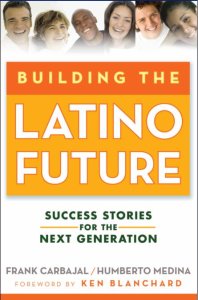
Building the Latino Future book cover
Photo: John Wiley & Sons, Inc.
Santa Clara resident Frank Carbajal, a life and business coach, and Humberto Medina, a speaker and consultant, teamed up to showcase the success stories of 49 Latinos in various professions and walks of life in the newly published book Building the Latino Future Success Stories for the Next Generation (Wiley, $24.95). The book is made up of brief summary biographies and a word of advice from each of the 49 individuals.
In addition to descriptions of the Latinos they chose to profile, the authors set out to provide readers with a framework they might rely on for their own future. The stories of the individuals they chose are designed to highlight their humble beginnings and rise to prominence in their field.
How to Use Your Energy to Attract Clients and Customers” audio recording

Presenter Heather Dominick, owner, EnergyRich Coaching, Inc.
A 106-minute audio recording including a presentation by Heather and the complete interview with Heather where she discusses:
- Heather’s step by step system for women entrepreneurs
- Her coaching philosophy that an individual needs to be business at a holistic level
- Core beliefs about creating magnificent marketing for your business
- How Heather transitioned from a high school drama teacher to a coach
- The three Os that characterized her life at the time
- Heather’s first steps to changing her life
Click here for information on How to Use Your Energy to Attract Clients and Customers
Not sure? Click here to listen to a short interview with Heather
Ready to buy? Select a format to add to your shopping cart:
Downloadable “ How to Use Your Energy to Attract Clients and Customers ” MP3 $119.95
Audio CD’s “How to Use Your Energy to Attract Clients and Customers ” $139.95
The 159-page hardcover book is divided into 49 chapters, one for each person profiled. The chapters are grouped in six sections: Focus, Unity, Tenacity, Unique Ability, Resiliency, and Education and a two-page Conclusion.
Included are 34 men and 15 women in academia, sports, business, entertainment, and politics from government as well as the private and private sectors such as: Aida Alvarez, former administrator, U.S. Small Business Administration; Raul Yzaguirre, former president, National Council of La Raza; Jeff Garcia, quarterback, National Football League; Elva Diaz, assistant professor, University of California at Davis; Douglas Patino, philanthropist; and Dick Gonzalez, former senior vice president, Human Resources, Safeway, Inc.
Carbajal is president of Es Tiempo, a coaching firm for small business owners and entrepreneurs. Medina is a speaker, director and consultant for The Ken Blanchard Companies.

Click here to buy Building the Latino Future
Comments:
Filed Under: Books
Posted by Elena del Valle on July 17, 2008
Information provided by our Event Partner

September 14-16, 2008
New York Marriott Marquis
The National Association for Multi-ethnicity in Communications (NAMIC)
will hold its 22nd Annual Conference, Diversity: Pipeline to Innovation,
September 14-16, 2008, at the New York Marriott Marquis.
The Annual NAMIC Conference is the communications industry’s premier
forum focused on diversity as a business imperative. The best and
brightest leaders will address emerging trends in ad sales, corporate
diversity & inclusion, digital media and leadership development.
Neil Smit, president and CEO, Charter Communications and David Zaslav,
president and CEO, Discovery Communications are Honorary Co-Chairs.
Conference highlights include the unveiling of NAMIC’s 2008 employment
research findings, 15th Anniversary L. Patrick Mellon Mentorship Program
luncheon, presentation of the Mickey Leland Humanitarian Achievement
Award, Excellence in Multi-cultural Marketing Awards (EMMAs), Diversity
in Communications Career Expo and more.
Register online at www.namic.com. For information, contact Sandra
Girado, Meetings and Events Manager, at 212-594-5985, ext. 23 or
sandra.girado@namic.com.
About NAMIC:
NAMIC (National Association for Multi-ethnicity in Communications) is
the premier organization focusing on multi-ethnic diversity in the
communications industry. Founded in 1980 as a non-profit trade
association, today NAMIC is comprised of 2,000 professionals belonging
to a network of 17 chapters nationwide. Through initiatives that focus
on education, advocacy and empowerment, NAMIC champions equity and
inclusion in the workforce, with special attention given to ensuring
that the leadership cadres of our nation’s communications industry
giants reflect the multi-ethnic richness of the populations they serve.
For more information, please visit namic.com.
Posted by Elena del Valle on July 17, 2008

John Moore, CTO and vice president of development, eTapestry
Photos: eTapestry
In 2006, eTapestry, an Indianapolis-based company, began creating a multilingual version of its on-demand fund raising software at the request of Spanish-speaking clients in San Diego, Miami, and Houston. After receiving positive feedback from early adopters, the developers made changes necessary to expand the eTapestry software into broader domestic and international markets allowing eTapestry to release a Spanish language version of the fund raising software in early July 2008.
“With eTapestry users accessing their data from points all over the globe, it was plain to see that eTapestry’s on demand software was opening up new opportunities for organizations everywhere,” said Jay Love, chief executive officer, eTapestry.
The Spanish language software was initially developed to help organizations who have some users who want to use the database in English, and other users who prefer Spanish. Company representatives believe the new Spanish language version is also ideally suited for organizations in Mexico, Latin America, and other Spanish speaking locales.
The target audience for the software is nonprofit organizations. According to a company representative, customers range from very small organizations with just a few hundred records to large organizations with hundred of thousands of records.
This is the first time company representatives have targeted the United States Latino market. The company promoted the new software by distributing a press release recently; and showcasing it during seminars, shows, and presentations.
“The need for automation and data segmentation is universal, but from the very beginning, eTapestry was architected with an eye toward offering the product on an international scale,” said John Moore, chief technology officer and vice president of development, eTapestry.
Target Latinos effectively by anticipating changes in the market with
“Hispanic Projections with 2007-08 update” audio recording

Presenter Roger Selbert, Ph.D.
Find out
- About Latino buying power growth in the future
- How Latino market growth compares with other markets in the U.S.
- What drives the rise of Latino economic clout
- Who should target the Latino market
- What is the size of the Hispanic affluent market
- If the luxury Latino market is growing
Stay ahead of your competition with “Hispanic Projections”
“This framework allows eTapestry to concentrate on how nonprofit organizations run their business rather than the traditional maintenance overhead of maintaining multiple versions of the software. Being a Software as a Service (SaaS) offering, we are positioned to rapidly evolve the product in a new market. We don’t have the limitation of client-installed software so our release cycle can be very aggressive. The customers will realize the benefits much quicker because their suggestions are incorporated into the product within a few weeks rather than months.”
ETapestry users pay a monthly rate based on the size of the database and number of concurrent users. It starts at $36 per month for one user and up to 1,000 records. The cost for 1,000 to 5,000 records is $112 per month and the pricing increases accordingly depending on the number of records. Additional services are offered a la carte, allowing each organization to add extra services at their discretion.
The Spanish language software launch complimented the international development plans of Blackbaud, eTapestry’s parent company. Now the two companies are working together to introduce eTapestry Espanol to Latin America.

Andrew Mosawi, vice president, Blackbaud
“The nonprofit community in Latin America is rapidly growing and needs software to better manage donor relations and overall accountability,” said Andrew Mosawi, vice president of international business development, Blackbaud. “It is a market that has been under served by the nonprofit software industry thus far, and we are pleased to provide an on-demand solution that is tailored to the unique needs of these growing organizations.”
Founded in 1999, eTapestry is a web-based donor database and communications management system that delivers software over the Internet, allowing access from desktops, laptops and mobile devices. The company offers its 3,000 customers website development, e-commerce and advanced email tools.
Hispanic Marketing and Public Relations Understanding and Targeting America’s Largest Minority book

“A must resource for practitioners/professionals expecting to reach US Hispanics; also valuable for college programs in marketing, public relations and communications. Highly recommended.”
Choice magazine
Click here for information on the Hispanic Marketing & Public Relations books
Posted by Elena del Valle on July 16, 2008
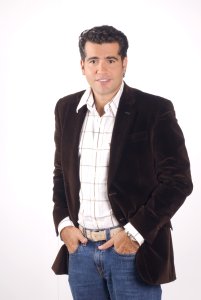
Carlos Calero, host, “Como en Casa“
Photos: LAETV
Latinamerican Ethnic TV (LAETV) recently launched a new a live televised magazine show, “Como en Casa” hosted by Carlos Calero, a Colombian journalist. The Spanish language program began broadcasting in April 2008 on Saturdays and Sundays on TV Colombia, RCN Nuestra Tele’s international signal distributed via satellite through DishLATINO and several cable operators.
The program will air from 8 pm to 12:30 am (Colombian time) on the weekends and be available in the United States, Mexico, El Salvador, Costa Rica, Panama, Honduras, Guatemala, Curaçao, Ecuador, Venezuela, the Dominican Republic, Aruba, Puerto Rico, Spain, New Zealand and Australia.
Make your ads resonate with Hispanics
Listen to C&R’s Research Director Liria Barbosa in
“Hispanics’ Perspective on Advertising” audio recording

Liria Barbosa gives a presentation and participates in an extended Q&A discussion about
• Type of ads Latinos prefer
• Latino top media choices
• Percent of Latinos who tried products because of ads
• Percent of Latinos who purchased products because of ads
• What makes an ad “Hispanic”
• If ad language is important for bicultural Latinos
• What to keep in mind when targeting bicultural Latinos with ads
Click here for information on Hispanic Perspectives on Advertising
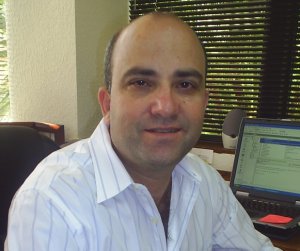
Kurt Pflucker, president, LAETV
“We’re proud to be the sole U.S. representative of TV Colombia, RCN Nuestra Tele’s international signal which brings this innovative concept to Hispanics. The program will not only help its viewers remain connected to their roots and culture, but will provide advertisers a different space which will allow them to be more direct in their messaging and to capture the attention and loyalty of its audience,” said Kurt Pflucker, president of LAETV.
“Como en Casa” is divided into three parts. The first part of the program includes live: “The Theme of the Day,” “The Musical Scene,” “Gossip Invited Guests,” “The Cultural Scene,” “Health” and “The Invited Product.” During the last section, broadcast on Sundays only, the host will promote a Latin American product.
“We are pleased with the benefits acquired by the commercial participation on the program ‘Como en Casa,’ achieving an increase in clients at an international level and equally an increase in telephone calls from several countries and states throughout the U.S. Additionally when Carlos Calero used one of our models, the reaction from the public since then has been excellent,” said Carlos Osorio of Cocoa Jeans, an advertiser.
The second part of “Como en Casa” will provide an overview of some Latin American newspapers. During this segment, viewers will be able to virtually chat with the program staff, become a correspondent and share information online. Segment participants will also be offered the opportunity to purchase classified ads, recommend a page on the Internet and participate in a virtual pageant and travel album.
The third part of “Como en Casa” includes prerecorded segments on national and international gossip, legal advice for immigrants, investment projects, cooking, nostalgia, destinations, behind the scenes and Latin American inventions.
Latinamerican Ethnic TV is a United States Hispanic cable and satellite television sales rep firm that has exclusive agreements with 14 Latin-American television networks in the United States market.
“Best in Class Hispanic Strategies” audio recording


Presenters Carlos Santiago and Derene Allen
-
Find out what makes 25 percent of the top 500 Hispanic market advertisers out perform the remaining companies
-
Discover what questions to ask, steps to take to be a Best in Class company
Click here for more about “Best in Class Hispanic Strategies” audio recording
Posted by Elena del Valle on July 15, 2008
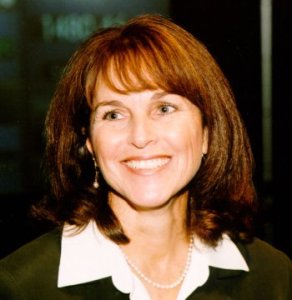
Cathy Baron Tamraz, president and CEO, Business Wire
Photos: Business Wire, impreMedia
Last week, Business Wire launched LatinoWire, a multi-channel service targeting United States Latinos in English and Spanish. Business Wire executives hope an exclusive distribution relationship with impreMedia, a major player in the market, announced at the same time will boost the service.
Business Wire representatives estimate tens of thousands of individuals and 1,200 media across the country, including 30 impreMedia online and print outlets, will receive their LatinoWire press release materials.
“LatinoWire is reaching the publications and media that the market relies on,” said Tom Becktold, senior vice president, Marketing at Business Wire. “We know that there is a large amount of interest because of past distribution through third parties. We think this is going to be extremely well received, especially with impreMedia.”
“Best in Class Hispanic Strategies” audio recording


Presenters Carlos Santiago and Derene Allen
-
Find out what makes 25 percent of the top 500 Hispanic market advertisers out perform the remaining companies
-
Discover what questions to ask, steps to take to be a Best in Class company
Click here for more about “Best in Class Hispanic Strategies” audio recording

Arturo Duran, chief executive officer, impreMedia Digital
“We are extremely pleased to partner with Business Wire and to bring Business Wire’s LatinoWire content to our online readers on an exclusive basis,” said Arturo Duran, chief executive officer of impreMedia Digital. “Through our unique partnership, impre.com users will have the ability to receive news directly from the companies making announcements, all with one convenient click. We believe that this is a significant benefit for those who come to impre.com for the latest in business and financial news affecting the Hispanic community.”
Although Business Wire staff have blanketed as many Spanish language publications as possible, the majority of the reach of the new service will be to English language publications. The idea, said Becktold by phone from California, is to reach consumers of English and Spanish language media. In Los Angeles, for example, LatinoWire reaches the Los Angeles Times in English and La Opinion in Spanish.
Business Wire has received much positive feedback in relation to LatinoWire. From a resources perspective the company’s interest is evidenced by the assignment of a dedicated team to the new service launch. Not all Business Wire services receive that kind of support. Four full-time staff will work on LatinoWire and between eight and ten staff will dedicate part of their time to the new Latino oriented service.
“Moving Beyond Traditional Media Measurement: measuring conversations and social media” audio recording

Presenter Katie Delahaye Paine, founder, KDPaine & Partners
Find out about
- Issues affecting online public relationships today
- Testing relationships as part of a survey
- Measuring ethnic group relationships
- Measuring foreign language communications in a similar ways to English
- Biggest challenges measuring conversations and social media
- Measuring online relationships with little or no money
Click here for information on “Moving Beyond Traditional Media Measurement”
“ImpreMedia has quickly established itself as the nation’s premier Hispanic multimedia company, providing unparalleled access to a highly desirable demographic audience,” noted Cathy Baron Tamraz, president and chief executive officer, Business Wire. “We are extremely proud to be affiliated with the dominant leader in a market destined to grow in importance.”
LatinoWire news will reach reporters through a direct publication feed via the company’s proprietary annex system. Major wire services like Associated Press and Notimex also will receive the updates. As part of the partnership with impreMedia, LatinoWire news releases will have guaranteed placement on impreMedia websites. This placement will be distinct from the publications’ editorial content.
ImpreMedia is a leading publisher of Spanish language newspapers in the country. The company owns publications in 17 cities and has 26 online and print properties targeting the United States Hispanic population.
Business Wire, a Berkshire Hathaway company, is utilized by member companies and organizations to transmit their news releases, regulatory filings, photos and other multimedia content to journalists, news media, trade publications, institutional and individual investors, financial information services, regulatory authorities, Internet portals, information web sites, business-to-business decision-makers and consumers.
Posted by Elena del Valle on July 14, 2008

Marci Shimoff, author, Happy for No Reason
A podcast interview with Marci Shimoff, author, Happy for No Reason 7 Steps to Being Happy from the Inside Out (Free Press, $24.95), is available in the Podcast Section of Hispanic Marketing & Public Relations, HispanicMPR.com. During the podcast, Marci discusses her book and how to find happiness for no reason with Elena del Valle, host of the HispanicMPR.com podcast.
Marci is also author of the self-help book Chicken Soup for the Soul. Her six bestselling titles in the series, including Chicken Soup for the Woman’s Soul and Chicken Soup for the Mother’s Soul, have met with stunning success, selling more than 13 million copies worldwide in 33 languages and have been on The New York Times bestseller list for 108 weeks.
Marci is a featured teacher in the international film and book The Secret. Her new book, Happy for No Reason was published January 2008 and offers an approach to experiencing deep and lasting happiness.

Click here to buy Happy for No Reason
Marci has inspired many people around the world, sharing her methods for personal fulfillment and professional success. As president and co-founder of the Esteem Group she delivers keynote addresses and seminars on self-esteem, self-empowerment, and peak performance to corporations, professional and non-profit organizations, and women’s associations. She has been a trainer for Fortune 500 companies, including AT&T, General Motors, Sears, Kaiser Permanente, and Bristol-Myers Squibb.
Marci earned her MBA from University of California, Los Angeles (UCLA) and holds an advanced certificate as a stress management consultant. She is a founding member and on the board of directors of the Transformational Leadership Council, a group of 100 top leaders serving over ten million people in the self-development market.
To listen to the interview, scroll down until you see “Podcast” on the right hand side, then select “HMPR Marci Shimoff,” click on the play button below or download the MP3 file to your iPod or MP3 player to listen on the go, in your car or at home. To download it, click on the arrow of the recording you wish to copy and save it to disk. The podcast will remain listed in the July 2008 section of the podcast archive.
“Happy for No Reason” audio recording

Presenter Marci Shimoff, author, Happy for No Reason 7 Steps to Being Happy from the Inside Out (Free Press, $24.95) and president Esteem Group
What: An audio presentation by Marci Shimoff and Q&A with Marci Shimoff and HispanicMPR.com audio program host Elena del Valle about finding happiness.
“Happy for No Reason” audio recording consists of 89 minutes of useful insights and information by the internationally famous author and speaker.
Available exclusively on HispanicMPR.com!
What you receive: Downloadable recording of a 39-minute audio presentation “Happy for No Reason” and a bonus 50-minute interview of Marci Shimoff.
Ready to buy? Select a format to add to your shopping cart:
Downloadable MP3 of Happy for No Reason $119.95
Audio CDs of Happy for No Reason $139.95
More information on “Happy for No Reason” audio recording with Marci Shimoff






































